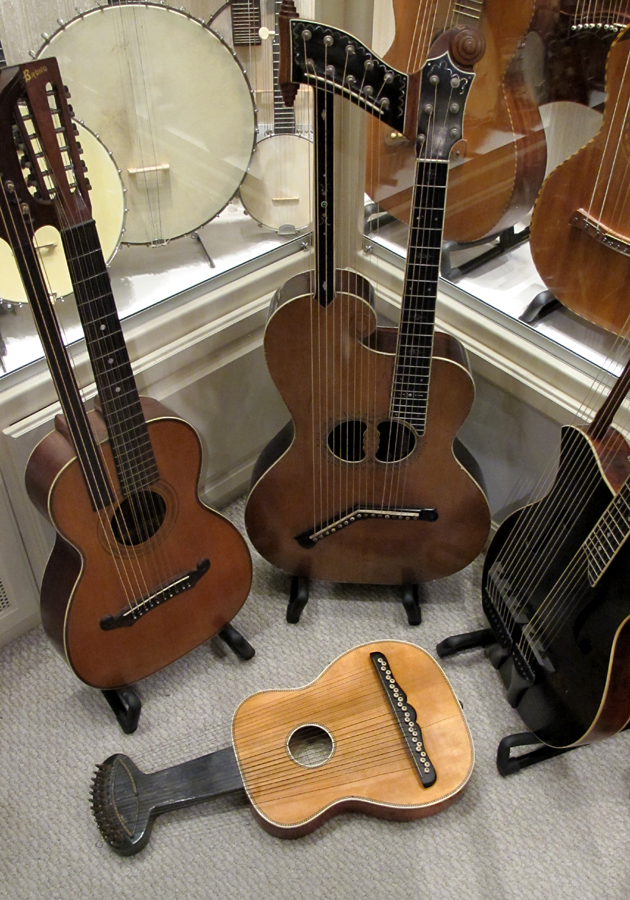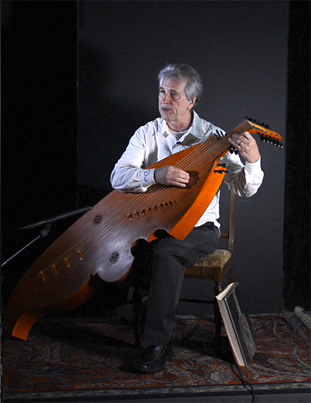A few weeks ago, I blogged about the unique one-off “nightmare lute” (at left) and mentioned the collection it had come from.
I am now happy to report that Mr. Erdmann’s widow Sabine and I collaborated to tell the world the story of her late husband and his unique private collection. It’s a story with a less-than-happy ending, one that echoes the nagging fears of many of us.
Thank you to the American Musical Instrument Society for publishing it as the cover story of their Winter, 2018 Newsletter.
 Please enjoy; you needn’t be an AMIS member (though it couldn’t hurt!) to read the PDF and fill your screen with Ms. Erdmann’s never-before-published photos.
Please enjoy; you needn’t be an AMIS member (though it couldn’t hurt!) to read the PDF and fill your screen with Ms. Erdmann’s never-before-published photos.
Besides the lute, I won two other of Walter’s instruments in the mentioned auction, which I wrote about in the previous AMIS Newsletter. Then recently, I was thrilled to be able to get a fourth, after learning that Pamela’s Music had won over 30 lots for their private collection and re-sale, one of which (as the underbidder) I was now ready to pay a premium for:

It is a rare and obscure “Harfen-Laute für Einarmige” (“harp-lute for one hand”), registered on May 16th, 1927 by one Sepp Müller of Kleinholthausen, Germany. Fortunately, an AMIS colleague was able to decipher and research the label for me, providing key information for this forgotten instrument (my thanks and appreciation to Dr. Gunther Joppig).
Neither harp nor lute, it’s actually a simple fretless zither in the shape of a miniature guitar, 12-1/2” wide and 25” long. I’ve long known of it from a single example in the Handel-Hauses collection in Germany. It’s rather cute, if a bit goofy, and has this curious headstock design with some sort of intriguing “you decide!” saddle option – where the metal tube saddle for the 25 strings is split in half, either half then able to lie in the upper or lower troughs that form an elliptical pattern.

On both specimens, the (default?) stringing is with the left side placed high, the right side low. I see no remotely advantageous reason for such a design, do you? I can only guess that the separation is related to the (unknown) tuning ; accompaniment/melody is what it looks like to me.

Shown to scale with various harp guitars.

The label shows this instrument and a second design in more of a “lute” shape, perhaps the nominal form behind the instrument’s term. Of course, “zithern” would have been a better choice than “harfen” (harp). The “schutzmarke” (trademark) consists of the illustration of the two instrument designs and monogram “S. M.” (Sepp Müller). “No. 1004” would be the stamped serial number – what I would surmise indicates the fourth instrument built (that this invention died an ignoble death is perhaps unsurprising). The handwritten “D.R.G.M. 996 378” signifies a 3-year “lower level patent” registration.
Besides the (now four) Erdmann instruments I was lucky to obtain, here are the lots from the Mehlis Auction (where the collection was liquidated) that I also found rare and interesting (most undocumented and now scattered to the four winds):

You see now why my “shopping list” was so long…
You did good, Walter – sorry we never met.







Hi Gregg, thank you for this impressive article for and about Walter Erdmann. When I started collecting guitars about 1975 I often was inspired by his Museum and his instruments. I offen visited him in his Museum and that were special days to meet him and to talk with him about the instruments. It was a great pleasure and I never will forget.
Thank you Walter.
Rainer Krause